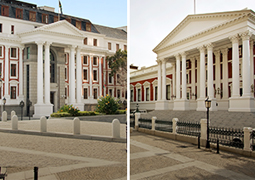
Parliament, Tuesday 02 January 2024 – Today we are reminded of the unfortunate fire incident that ravaged the National Assembly building, including the National Assembly Chamber, hundreds of offices of Members of Parliament and staff, and inflicted extensive damage to parts of the historic Old Assembly Chamber.
The incident inflicted a collective national trauma on South Africans, a memory that will linger for many years. In the face of this crisis, our resilience as a nation and as a crucial arm of the state was profoundly tested. Together with the people of South Africa, we navigated the unimaginable and we advanced and fulfilled our constitutional obligations to the nation.
In the first year after the fire, Parliament promptly initiated a business continuity management framework to minimise disruptions. This included securing alternative venues for joint sittings of the two Houses for the State of the Nation Address and National Assembly sessions, repairing the ICT system in the Chamber of the National Council of Provinces, and facilitating both virtual and physical committee sittings.
A significant portion of the first year was dedicated to damage assessment by agencies appointed by the Department of Public Works and Infrastructure, a process that spanned most of 2022. Concurrently, Parliament secured over R2 billion for reconstruction of the damaged buildings and R118 million for unforeseen expenditures due to the fire and COVID-19, in collaboration with the National Treasury.
Last year, marking the first year of the fire, the Presiding Officers of Parliament emphasised the urgency of restoring Parliament. Following a meticulously designed rebuilding blueprint, 2023 was dedicated to laying the groundwork for the reconstruction.
Early in 2023, Parliament and the Development Bank of South Africa (DBSA) formed a partnership for the rebuilding project. The agreement encompassed capacity development, technical support, and implementation of infrastructure projects. This involved refurbishing the Old Assembly and National Assembly buildings and the link building, clearing rubble for detailed assessments, and remodelling 155 offices in the 90 Plein Street building to accommodate MPs' physical return to the precincts.
Significant progress has been made, particularly in creating the 155 offices for MPs and preparing the construction site. Both were the two major objectives for 2023 in terms of the rebuilding project roadmap. All tasks were completed within the set timelines.
The reconfiguration of the fourth and fifth floors of the 90 Plein Street Building has provided alternative office space for MPs, offering appropriate workspace during restoration.
Concurrent with office remodelling, Parliament completed site preparation for reconstruction, including rubble and debris removal, as well as asset verification and removal from damaged buildings. The site is now primed for construction.
An essential aspect of site preparation was also installing temporary roofing on the damaged Old Assembly building, protecting the upcoming construction from adverse weather.
Following rubble removal, the DBSA conducted detailed site assessments, prepared designed concepts for the damaged buildings, prepared elemental costing, and presented budget estimates as well as an implementation plan to Parliament. Parts of the building found to be structurally unstable will be demolished as part of the actual rebuilding work. This will be in line with the South African Heritage Resources Agency requirements. The stage 2 design concepts, compliant with National Building Regulations, will incorporate green building principles. A green Parliament building would not only be an investment in environmental sustainability but also bring economic, health, and social benefits, aligning the values and practices of the institution with the pressing need for environmental sustainability.
The heritage permit application process is underway, including stakeholder engagements. A pre-qualification process for contractors has begun to expedite procurement upon completion of detailed designs and documentation. These designs aim to promote open access to the Parliament precinct, foster professionalism, and teamwork, and highlight South Africa's rich cultural diversity.
Construction is set to commence in the first quarter of 2024 and conclude at the end of 2025.
As previously stated, this reconstruction presents an unparalleled opportunity to design spaces tailored to a democratic Parliament's needs and to modernise its digital infrastructure. The previous Parliament buildings were designed to meet the specific, limited requirements of colonial and apartheid-era governance. However, the new Parliament building is being developed to effectively address the demands of a democratic era. This includes improving oversight, leveraging advancements in modern communication technology, fostering increased public participation, and facilitating more effective law-making processes.
At this significant moment, we remind South Africans that the construction of the new Parliament building is not just an ordinary project – it is one of the most historic and crucial national endeavours. This undertaking transcends mere bricks and mortar. It is about shaping our future, realising the collective hopes and aspirations of every South African. This project belongs to each and every citizen. It is a shared venture and in that spirit, every South African will be afforded the opportunity to voice their opinions and contribute to the decision-making process regarding the design and functionality of their Parliament.
ISSUED BY THE PARLIAMENT OF THE REPUBLIC OF SOUTH AFRICA

